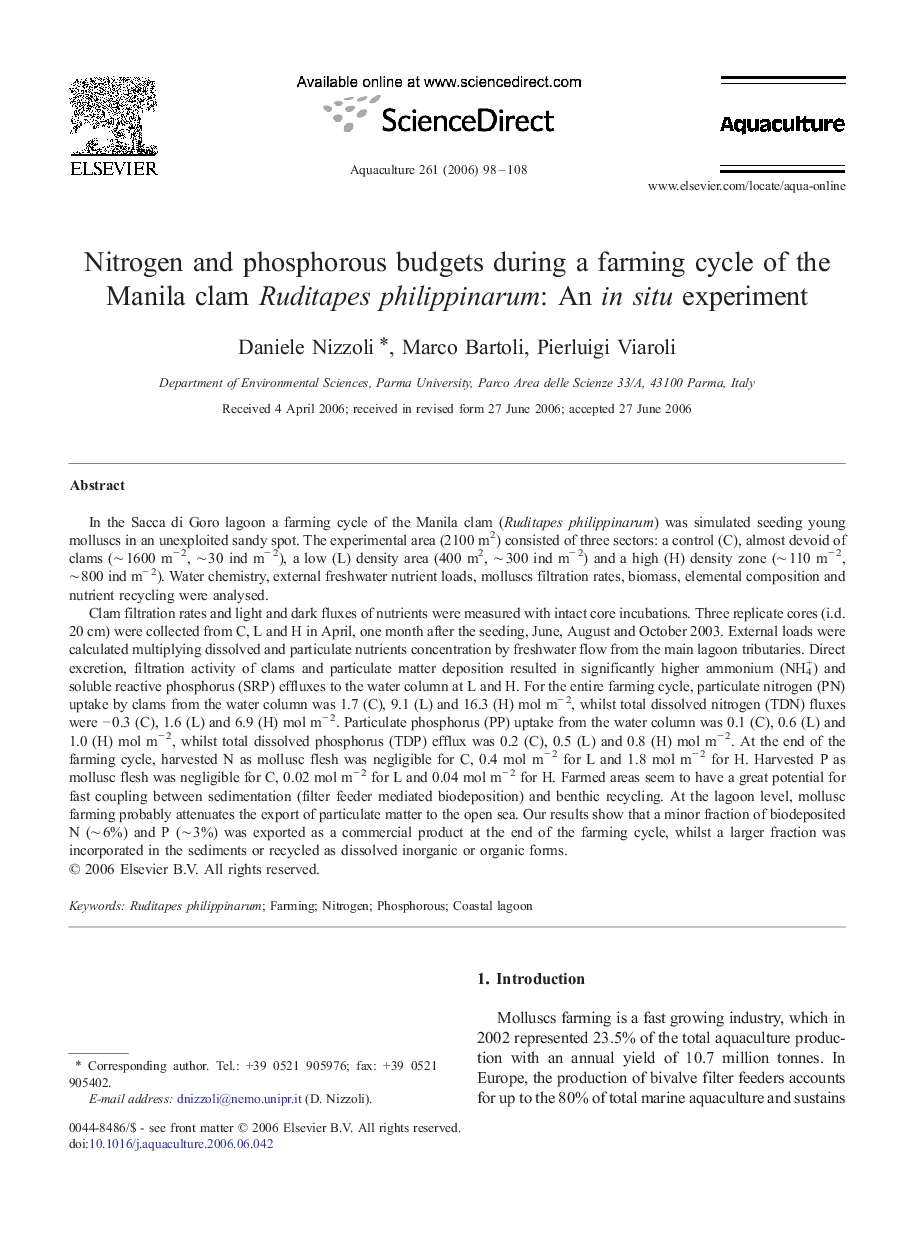| کد مقاله | کد نشریه | سال انتشار | مقاله انگلیسی | نسخه تمام متن |
|---|---|---|---|---|
| 2425724 | 1105347 | 2006 | 11 صفحه PDF | دانلود رایگان |

In the Sacca di Goro lagoon a farming cycle of the Manila clam (Ruditapes philippinarum) was simulated seeding young molluscs in an unexploited sandy spot. The experimental area (2100 m2) consisted of three sectors: a control (C), almost devoid of clams (∼ 1600 m− 2, ∼ 30 ind m− 2), a low (L) density area (400 m2, ∼ 300 ind m− 2) and a high (H) density zone (∼ 110 m− 2, ∼ 800 ind m− 2). Water chemistry, external freshwater nutrient loads, molluscs filtration rates, biomass, elemental composition and nutrient recycling were analysed.Clam filtration rates and light and dark fluxes of nutrients were measured with intact core incubations. Three replicate cores (i.d. 20 cm) were collected from C, L and H in April, one month after the seeding, June, August and October 2003. External loads were calculated multiplying dissolved and particulate nutrients concentration by freshwater flow from the main lagoon tributaries. Direct excretion, filtration activity of clams and particulate matter deposition resulted in significantly higher ammonium (NH4+) and soluble reactive phosphorus (SRP) effluxes to the water column at L and H. For the entire farming cycle, particulate nitrogen (PN) uptake by clams from the water column was 1.7 (C), 9.1 (L) and 16.3 (H) mol m− 2, whilst total dissolved nitrogen (TDN) fluxes were − 0.3 (C), 1.6 (L) and 6.9 (H) mol m− 2. Particulate phosphorus (PP) uptake from the water column was 0.1 (C), 0.6 (L) and 1.0 (H) mol m− 2, whilst total dissolved phosphorus (TDP) efflux was 0.2 (C), 0.5 (L) and 0.8 (H) mol m− 2. At the end of the farming cycle, harvested N as mollusc flesh was negligible for C, 0.4 mol m− 2 for L and 1.8 mol m− 2 for H. Harvested P as mollusc flesh was negligible for C, 0.02 mol m− 2 for L and 0.04 mol m− 2 for H. Farmed areas seem to have a great potential for fast coupling between sedimentation (filter feeder mediated biodeposition) and benthic recycling. At the lagoon level, mollusc farming probably attenuates the export of particulate matter to the open sea. Our results show that a minor fraction of biodeposited N (∼ 6%) and P (∼ 3%) was exported as a commercial product at the end of the farming cycle, whilst a larger fraction was incorporated in the sediments or recycled as dissolved inorganic or organic forms.
Journal: Aquaculture - Volume 261, Issue 1, 16 November 2006, Pages 98–108